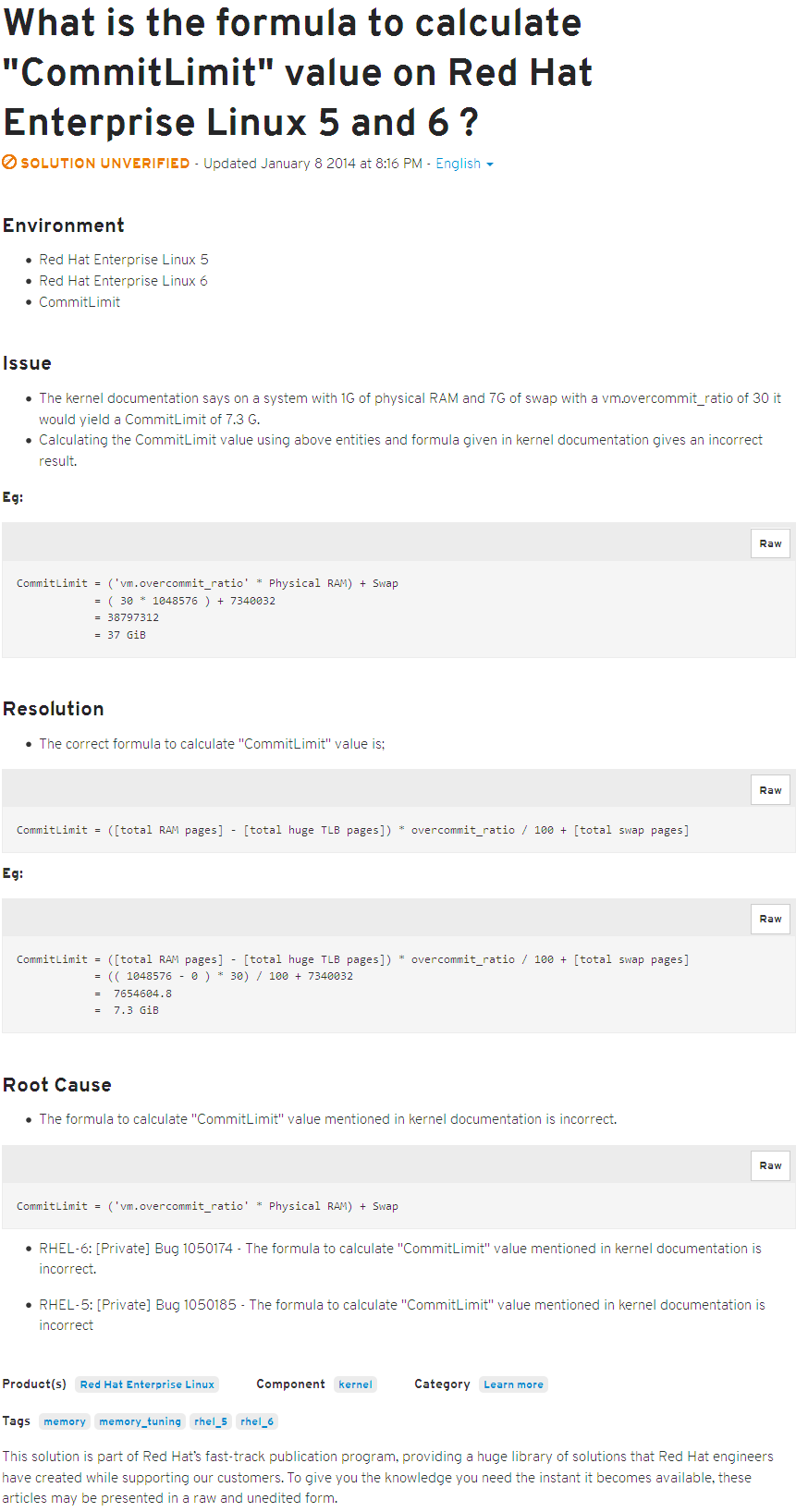Memory Overcommit的意思是操作系统承诺给进程的内存大小超过了实际可用的内存。一个保守的操作系统不会允许memory overcommit,有多少就分配多少,再申请就没有了,这其实有些浪费内存,因为进程实际使用到的内存往往比申请的内存要少,比如某个进程malloc()了200MB内存,但实际上只用到了100MB,按照UNIX/Linux的算法,物理内存页的分配发生在使用的瞬间,而不是在申请的瞬间,也就是说未用到的100MB内存根本就没有分配,这100MB内存就闲置了。下面这个概念很重要,是理解memory overcommit的关键:commit(或overcommit)针对的是内存申请,内存申请不等于内存分配,内存只在实际用到的时候才分配。
Linux是允许memory overcommit的,只要你来申请内存我就给你,寄希望于进程实际上用不到那么多内存,但万一用到那么多了呢?那就会发生类似“银行挤兑”的危机,现金(内存)不足了。Linux设计了一个OOM killer机制(OOM = out-of-memory)来处理这种危机:挑选一个进程出来杀死,以腾出部分内存,如果还不够就继续杀…也可通过设置内核参数 vm.panic_on_oom 使得发生OOM时自动重启系统。这都是有风险的机制,重启有可能造成业务中断,杀死进程也有可能导致业务中断,我自己的这个小网站就碰到过这种问题,参见前文。所以Linux 2.6之后允许通过内核参数 vm.overcommit_memory 禁止memory overcommit。
内核参数 vm.overcommit_memory 接受三种取值:
1.0 – Heuristic overcommit handling. 这是缺省值,它允许overcommit,但过于明目张胆的overcommit会被拒绝,比如malloc一次性申请的内存大小就超过了系统总内存。Heuristic的意思是“试探式的”,内核利用某种算法(对该算法的详细解释请看文末)猜测你的内存申请是否合理,它认为不合理就会拒绝overcommit。
2.1 – Always overcommit. 允许overcommit,对内存申请来者不拒。
3.2 – Don’t overcommit. 禁止overcommit。
关于禁止overcommit (vm.overcommit_memory=2) ,需要知道的是,怎样才算是overcommit呢?kernel设有一个阈值,申请的内存总数超过这个阈值就算overcommit,在/proc/meminfo中可以看到这个阈值的大小:
# grep -i commit /proc/meminfo
CommitLimit: 5967744 kB
Committed_AS: 5363236 kB
CommitLimit 就是overcommit的阈值,申请的内存总数超过CommitLimit的话就算是overcommit。
这个阈值是如何计算出来的呢?它既不是物理内存的大小,也不是free memory的大小,它是通过内核参数vm.overcommit_ratio或vm.overcommit_kbytes间接设置的,公式如下:
【CommitLimit = (Physical RAM * vm.overcommit_ratio / 100) + Swap】
注:
vm.overcommit_ratio 是内核参数,缺省值是50,表示物理内存的50%。如果你不想使用比率,也可以直接指定内存的字节数大小,通过另一个内核参数 vm.overcommit_kbytes 即可;
如果使用了huge pages,那么需要从物理内存中减去,公式变成:
CommitLimit = ([total RAM] – [total huge TLB RAM]) * vm.overcommit_ratio / 100 + swap
参见:

/proc/meminfo中的 Committed_AS 表示所有进程已经申请的内存总大小,(注意是已经申请的,不是已经分配的),如果 Committed_AS 超过 CommitLimit 就表示发生了 overcommit,超出越多表示 overcommit 越严重。Committed_AS 的含义换一种说法就是,如果要绝对保证不发生OOM (out of memory) 需要多少物理内存。
“sar -r”是查看内存使用状况的常用工具,它的输出结果中有两个与overcommit有关,kbcommit 和 %commit:
kbcommit对应/proc/meminfo中的 Committed_AS;
%commit的计算公式并没有采用 CommitLimit作分母,而是Committed_AS/(MemTotal+SwapTotal),意思是_内存申请_占_物理内存与交换区之和_的百分比。
$ sar -r
05:00:01 PM kbmemfree kbmemused %memused kbbuffers kbcached kbcommit %commit kbactive kbinact kbdirty
05:10:01 PM 160576 3648460 95.78 0 1846212 4939368 62.74 1390292 1854880 4
附:对Heuristic overcommit算法的解释
内核参数 vm.overcommit_memory 的值0,1,2对应的源代码如下,其中heuristic overcommit对应的是OVERCOMMIT_GUESS:
源文件:source/include/linux/mman.h
#define OVERCOMMIT_GUESS 0
#define OVERCOMMIT_ALWAYS 1
#define OVERCOMMIT_NEVER 2
Heuristic overcommit算法在以下函数中实现,基本上可以这么理解:
单次申请的内存大小不能超过 【free memory + free swap + pagecache的大小 + SLAB中可回收的部分】,否则本次申请就会失败。
源文件:source/mm/mmap.c 以RHEL内核2.6.32-642为例
0120 /*
0121 * Check that a process has enough memory to allocate a new virtual
0122 * mapping. 0 means there is enough memory for the allocation to
0123 * succeed and -ENOMEM implies there is not.
0124 *
0125 * We currently support three overcommit policies, which are set via the
0126 * vm.overcommit_memory sysctl. See Documentation/vm/overcommit-accounting
0127 *
0128 * Strict overcommit modes added 2002 Feb 26 by Alan Cox.
0129 * Additional code 2002 Jul 20 by Robert Love.
0130 *
0131 * cap_sys_admin is 1 if the process has admin privileges, 0 otherwise.
0132 *
0133 * Note this is a helper function intended to be used by LSMs which
0134 * wish to use this logic.
0135 */
0136 int __vm_enough_memory(struct mm_struct *mm, long pages, int cap_sys_admin)
0137 {
0138 unsigned long free, allowed;
0139
0140 vm_acct_memory(pages);
0141
0142 /*
0143 * Sometimes we want to use more memory than we have
0144 */
0145 if (sysctl_overcommit_memory == OVERCOMMIT_ALWAYS)
0146 return 0;
0147
0148 if (sysctl_overcommit_memory == OVERCOMMIT_GUESS) { //Heuristic overcommit算法开始
0149 unsigned long n;
0150
0151 free = global_page_state(NR_FILE_PAGES); //pagecache汇总的页面数量
0152 free += get_nr_swap_pages(); //free swap的页面数
0153
0154 /*
0155 * Any slabs which are created with the
0156 * SLAB_RECLAIM_ACCOUNT flag claim to have contents
0157 * which are reclaimable, under pressure. The dentry
0158 * cache and most inode caches should fall into this
0159 */
0160 free += global_page_state(NR_SLAB_RECLAIMABLE); //SLAB可回收的页面数
0161
0162 /*
0163 * Reserve some for root
0164 */
0165 if (!cap_sys_admin)
0166 free -= sysctl_admin_reserve_kbytes >> (PAGE_SHIFT - 10); //给root用户保留的页面数
0167
0168 if (free > pages)
0169 return 0;
0170
0171 /*
0172 * nr_free_pages() is very expensive on large systems,
0173 * only call if we're about to fail.
0174 */
0175 n = nr_free_pages(); //当前free memory页面数
0176
0177 /*
0178 * Leave reserved pages. The pages are not for anonymous pages.
0179 */
0180 if (n <= totalreserve_pages)
0181 goto error;
0182 else
0183 n -= totalreserve_pages;
0184
0185 /*
0186 * Leave the last 3% for root
0187 */
0188 if (!cap_sys_admin)
0189 n -= n / 32;
0190 free += n;
0191
0192 if (free > pages)
0193 return 0;
0194
0195 goto error;
0196 }
0197
0198 allowed = vm_commit_limit();
0199 /*
0200 * Reserve some for root
0201 */
0202 if (!cap_sys_admin)
0203 allowed -= sysctl_admin_reserve_kbytes >> (PAGE_SHIFT - 10);
0204
0205 /* Don't let a single process grow too big:
0206 leave 3% of the size of this process for other processes */
0207 if (mm)
0208 allowed -= mm->total_vm / 32;
0209
0210 if (percpu_counter_read_positive(&vm_committed_as) < allowed)
0211 return 0;
0212 error:
0213 vm_unacct_memory(pages);
0214
0215 return -ENOMEM;
0216 }

